
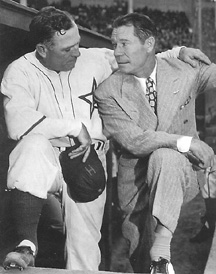
Joe E. Brown (Elmer the Great, Some Like It Hot) with manager Charlie Root. |
"Every night was a carnival at Gilmore Field, especially 1949 and 1950... You'd start a ball game and look up in the stands and see George Burns and Gracie Allen, Jack Benny, Cyd Charisse and Tony Martin, George Raft. Every night. It got so tickets were selling at a premium out there... It was very common in the late '40s for Mickey Cohen, the ex-gangster, to walk into Gilmore and sit directly behind the third base dugout with a couple of his muscles. He was a great fan. The theme song on the bench was that if anybody in that box said anything, just smile and wave."
—Stars First Baseman Chuck Stevens (Source: The Grand Minor League by D. Dobbins) |
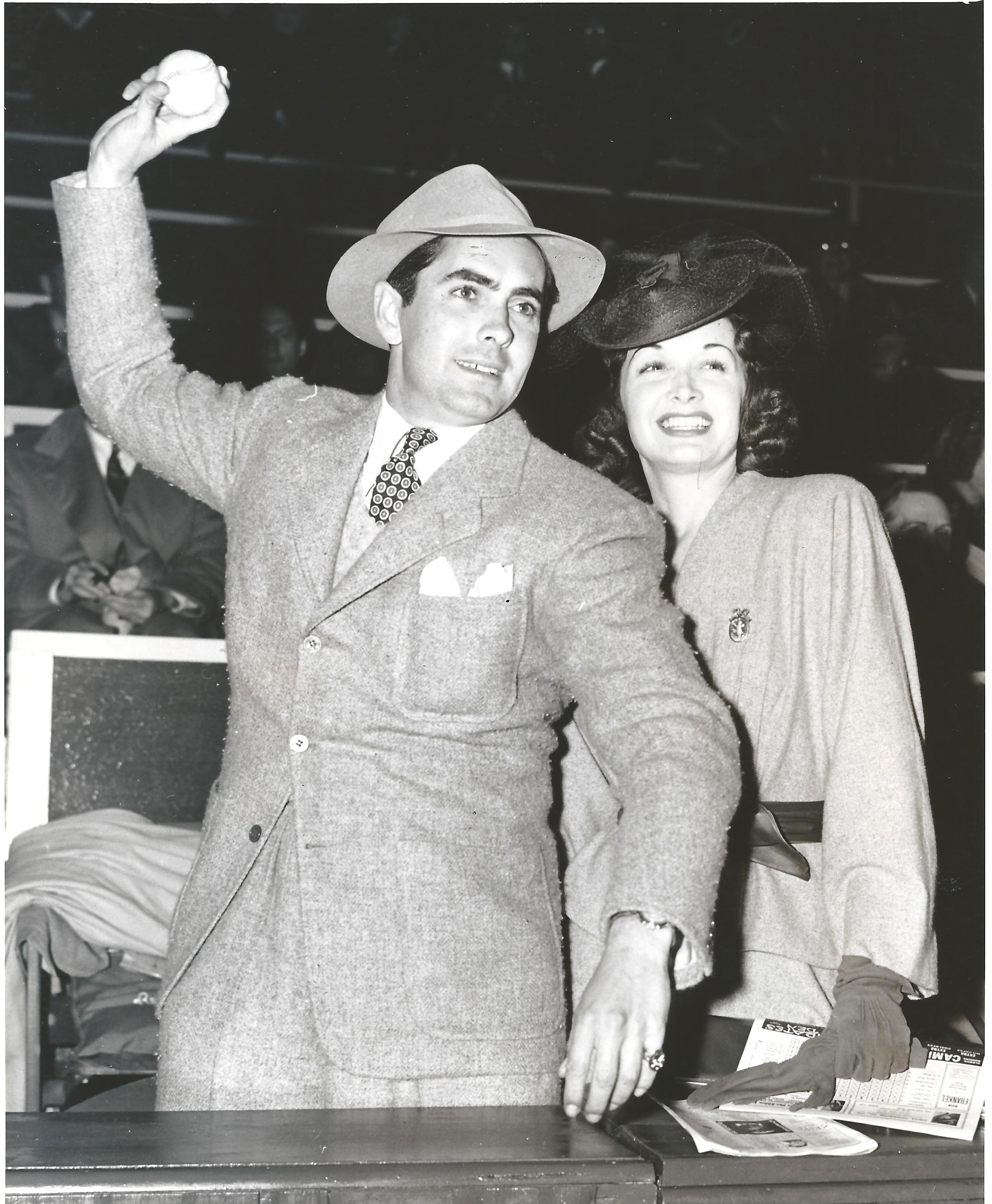
Tyrone Power throws out the first pitch beside the newly-single Gail Patrick in 1941. |
The first few seasons in Gilmore Field were not successful from a baseball standpoint, with the Stars always finishing in the second division—but a combination of star power and film studio-like marketing made the team a huge hit with the general public. It took a toll on its owner, though: Between learning how to run the most successful minor league franchise ever, and running the most famous restaurants in the country, Bob Cobb was probably stretched a little too thin. Nobody saw him in public anymore (especially after losses). He was up early every morning to oversee the opening of his four restaurants, and he slept during the day in his office at the Hollywood & Vine location so that he could attend the games at night. In 1940, Gail Patrick filed for a divorce for "mental cruelty," saying her husband had ignored her for weeks at a time. But a sign of the Stars' popularity was that despite all of the mental cruelty, Patrick never gave up her box seat by first base.¹
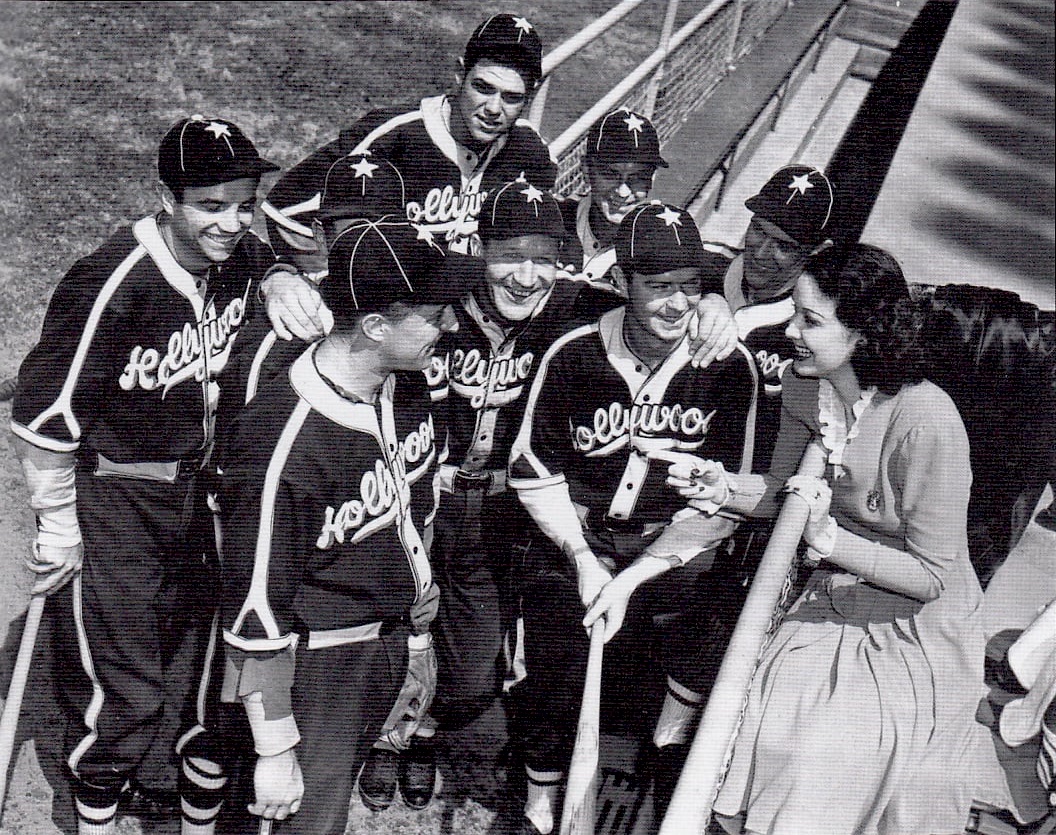
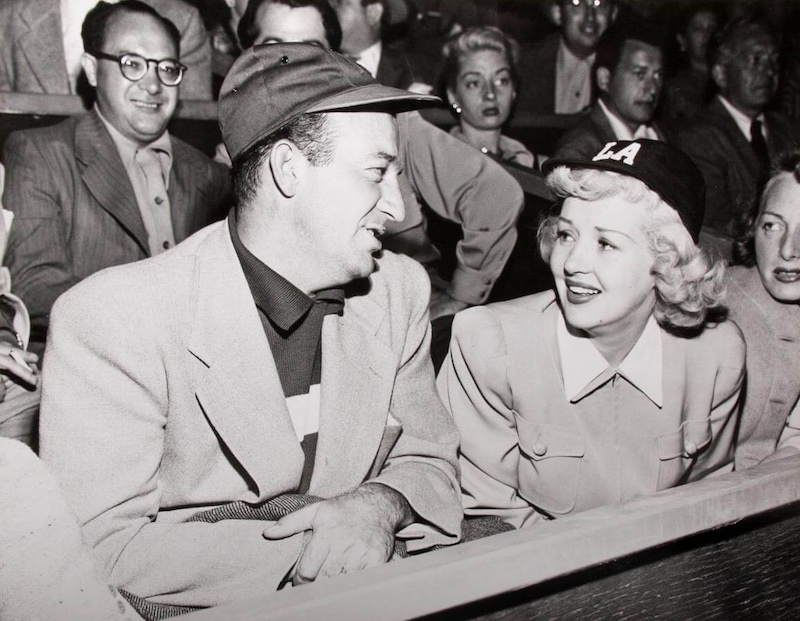
Bandleader Harry James sits with Betty Grable, who wore the wrong cap. Hope your limo isn't keyed too badly in the parking lot, Betty. |
To increase attendance, Cobb used the tactics that he learned from promoting his restaurants: Star power generated fan interest. The celebrities sat in the most visible places, so if the game wasn't good, the fans could star-gaze and watch Jack Benny or Groucho Marx, instead. Abbott and Costello even performed their "Who's on first" routine for the crowd before a game. But Cobb needed star power on the field, too. To that end, he signed Floyd Caves "Babe" Herman. Today, Herman is mainly recalled for reckless base-running ("three Dodgers on third"), fielding lapses (he angrily rejected the charge that a fly ball had once bounced off his head—saying it actually hit a shoulder), and off-the-field malapropisms. But he had an amazing 13-year pro career with a lifetime batting average of .324 and an impressive number of Dodger franchise season records that still still stand. He had grown up in Los Angeles County, and out of the pros, had returned home to start a turkey farm just a few miles from the front office of the Stars.
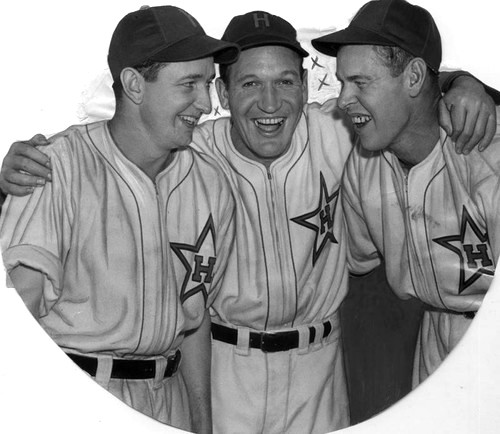
Herman (right) with coach Bill Sweeney (center), who got so frustrated with bad press and complaints from the board that he shot the lights out in the press room with a security guard's pistol. |
Cobb counted on fans and press excitement for bringing the "local boy" back home. Herman saw it as a way to play close to home so his family could attend games, and as a springboard to the movies (he doubled for Gary Cooper in "Pride of the Yankees"). But Herman also used it a business opportunity: He held out until opening day, and ended up with a large salary... and with the Brown Derby restaurants agreeing to buy all of their turkeys from his farm—which was also advertised on top of the scorecard in every Stars game program.
Babe's best baseball years were behind him, but he still did not disappoint. A Star from day #1 through the 1944 season, he was used mainly as a pinch hitter and always hit over .300, and in 1941 his .346 average was the best in league. The Hollywood fans loved him.
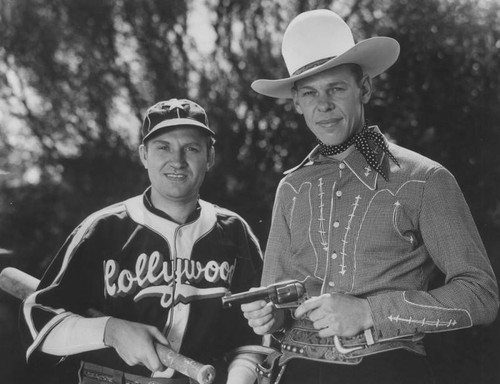
Babe Herman swaps outfits with singing cowboy and Stars fan Gene Autry in 1938 (Los Angeles Public Library: Herald Examiner Collection).
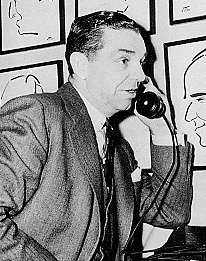
Bob Cobb at the Brown Derby. |
Despite some lean years for the PCL overall during World War II, the Stars were a massive success in Los Angeles—at least in attendance, if not in the standings. On September 24, 1945, the last place Stars were feted with a party at the Beverly Hills Hotel by a grateful show-biz community. Toastmaster Groucho Marx began the proceedings by saying, "We laughed at you guys all season. Here's your chance to even the score." Everybody then got their shots in—including Jack Benny, Joe E. Brown, George Jessel George Burns, Jimmy Durante, Parkyakarkus, Harry Ritz, Bill Frawley, Ronald Reagan, Oscar-winning comedy writer Ben Hecht, Harry Ruby, and all of Groucho's brothers—even Zeppo and Gummo. (The whole list is in the October 4th Sporting News, here.) Benny said he felt lucky to be a Stars fan that year... because he had been in Germany all season and missed every game. Burns said, "We all love the Hollywood Stars. And why shouldn't we? Didn't we make a fortune this season betting against them?"
In 1946, Cobb turned down an offer from MLB legend Hank Greenberg to purchase the team for $750,000. The next year, new coach Jimmie Dykes told reporters that the team had made $4 million dollars that season—an astronomical number when you consider that the asking price for the entire franchise had been just $40,000 eight years before. Based on that financial momentum, Cobb and the other PCL owners mounted a campaign to have the PCL officially made America's third major league. The league already paid competitive player salaries to those in the majors, and many players preferred the PCL because of the weather and nearly year-round schedules, so this was not a pipe dream.
However, the sticking point was that they were demanding the entire PCL be added as a package deal, instead of just the teams in the big cities like the Stars, Angels or San Francisco Seals—and not all of the other teams were so successful. Branch Rickey and other MLB honchos decided that most of the stadiums in the league were not up to the standards of MLB, and there was also concern that there wasn't a large enough market base in the Northwest to support a major league franchise.² Of all the PCL venues, only Wrigley Field in Los Angeles, seating 21,000, compared to the major league ballparks on the East Coast. Gilmore Field barely held 12,000.
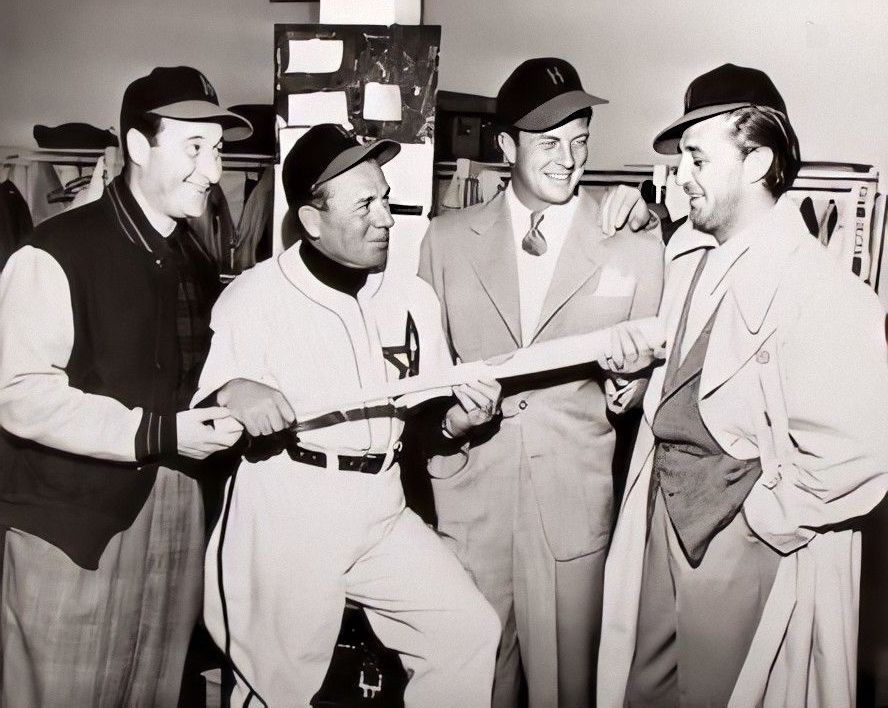
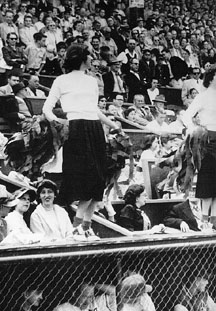
The Laker Girls? Nope—it's the 1952 Stars' cheerleading Squad. (Click to enlarge) |
Despite record crowds at the western stadiums (the Stars even out-drew some of the pro teams), the major league owners continued to reject the Coast League's request for major league status. But Bob Cobb wasn't done yet in this crusade. The Eastern teams complained that the PCL was too far away to reach by train or bus during the season, but the Stars were already chartering planes and flying to their away games. Cobb maintained that all that was needed was a six-year moratorium on the major league's drafting of PCL players. After using that time to build up its team rosters, the league would be able to compete at the same level as the National and American Leagues.³
MLB owners were unmoved, however (the fact that MLB owners didn't want to cut PCL franchises in on their profits, or pay to transport their teams over the Rocky Mountains, didn't help, either). But Cobb continued to push his plan of Major League status for the PCL throughout the 1950s. He even found a spot for a larger, modernized, MLB-appropriate stadium in a shallow, L-shaped canyon in Elysian Park, north of downtown Los Angeles, called Chavez Ravine, which would have fulfilled MLB's requirements. He had plans drawn up with escalators, child care, and luxury boxes (decades before they became a real thing). But the city government was unmoved. (More on this later.⁴)
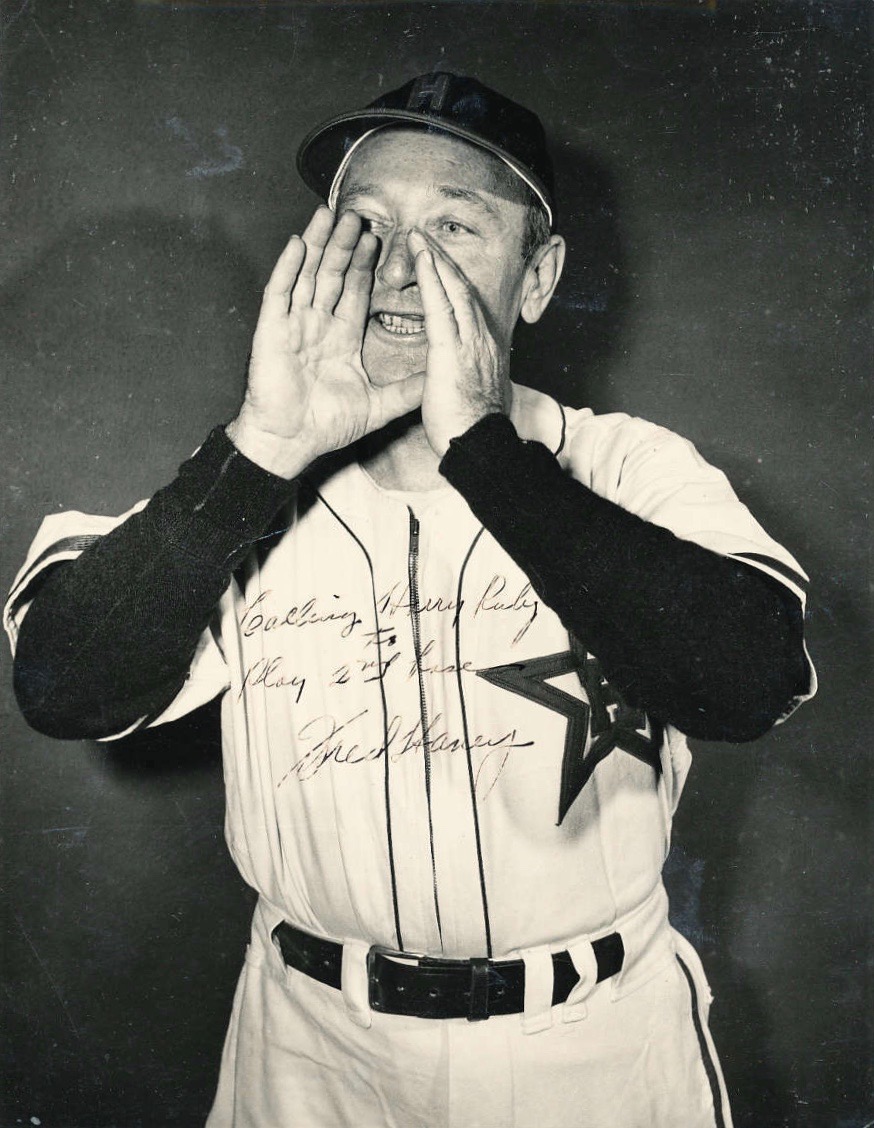 |
"CALLING HARRY RUBY: PLAY 2nd BASE." A photo signed to writer Harry Ruby ("Duck Soup") by Stars manager Fred Haney (1896-1977). As a player, Haney batted .352 and .309 with the Detroit Tigers in the early 1920's; in 9 PCL seasons Haney compiled a lifetime .300 batting average and led the league in stolen bases 4 times. After a stint coaching the St. Louis Browns (1939-41), Haney was hired as the radio play-by-play broadcaster for the Stars and Angels from 1943 until 1949, when he was named the manager of Hollywood. During his four years (1949-52) leading the team, the Stars won two pennants. As a reward, he was named manager of the Stars' parent club: the Pittsburgh Pirates, the worst team in the Major Leagues. Haney was fired after three straight last place finishes. In 1956 the Milwaukee Braves hired Haney to coach and won their only two pennants, as well as their only World Championship in 1957. Haney later served as the first general manager of Gene Autry's expansion Los Angeles Angels in the Major Leagues. (Photo: Collection of the author)
|
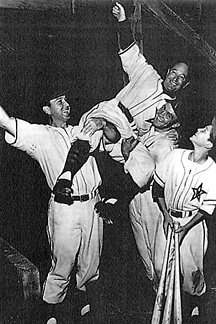 |
Despite the feud with the "Eastern League," there was plenty for the nearly 600,000 fans attending Stars games every season to cheer about: "The Hollywood Stars baseball team, owned by the Hollywood stars," as radio, TV and newspaper ads proclaimed, won the pennant in 1949. They were covered in the national press and appeared in films and TV shows. In 1950 the Stars had a second-straight 100-win season and Frankie Kelleher walloped 40 home runs. Cobb solidified his hold on the Stars in August of 1951, buying out George Young, the treasurer and director of the club, at $250 per share (roughly $75,000 in total). The team responded with more pennants, in 1952 and 1953, making them the most successful PCL franchise in the early fifties.
This success, ironically, was made possible through an agreement that Cobb and Collins reached with Branch Rickey, president of the major league Brooklyn Dodgers, and then later the Pittsburgh Pirates: Rickey gave them a fresh inflow of MLB talent to fill out the Hollywood roster, in exchange for the Stars giving Brooklyn the first shot at buying players on the Stars "reserve" list—which had protected certain Hollywood players from getting scooped by major league teams in the annual draft.⁵ In fact the Stars team from this era is considered by many to be one of the best minor league teams of all time. (Which in those rarified baseball times was actually saying something.)
In 1951, Coach Haney convinced his friend Casey Stengel to bring the New York Yankees out to Gilmore Field from their new Spring Training site in Phoenix, Arizona, during a publicity tour. The Yankees played three games against the Stars, and Hollywood took two—the first time the Bronx Bombers, featuring Joe DiMaggio and a young Mickey Mantle, had ever lost a series to a minor league team.⁶
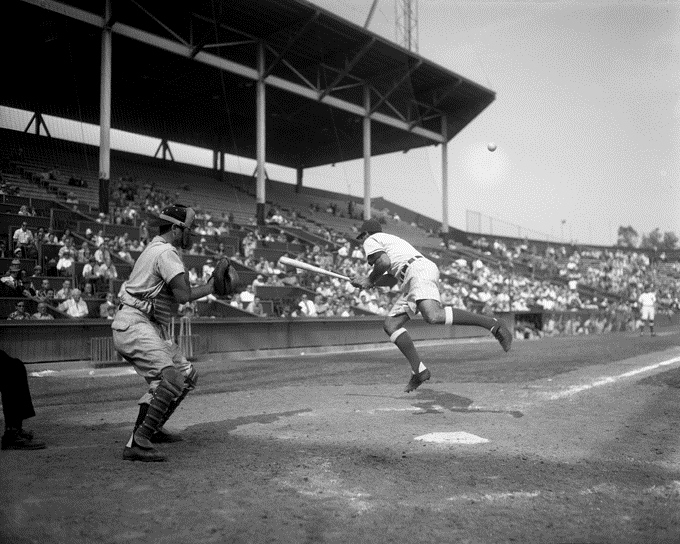
This is what happens when a grown man plays baseball in shorts and a t-shirt against pros in uniforms.
|
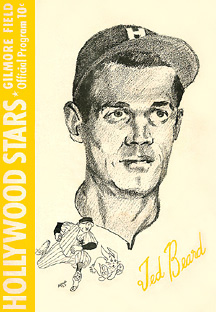 |
After the 1951 Pennant, a party was held in the Mayfair Room of the Beverly-Wilshire Hotel, with a very different mood than the last-place party from 1945. Groucho Marx was acting as emcee again, with 400 guests including Bill Frawley, Harry Ruby, Virginia Mayo, Gail Patrick, Gordon MacRae, Los Angeles Mayor Fletcher Bowron, and many others dining on filet mignon, to music provided by the Eddie Bergman Orchestra, and the Pete Dailey Dixieland Band in the adjoining refreshment lounge. Bob Cobb brought his 81-year-old mother to the party, and Groucho looked her over: "I don't know how old Mr. Cobb's mother is, but she's still young enough to play for the San Diego Padres," he said. Fred Haney tried to get away with only a bow to the crowd, saying, "I think I made my speech about two weeks ago." Groucho retorted, "Make it over again. They weren't listening anyway."⁹ He revealed that the Stars were the best team he'd ever coached—including major league clubs.
The major leagues were vulnerable now, because Congressional hearings were being held on baseball's exemption from anti-trust laws, and the situation involving the Pacific Coast League was receiving special focus. This was the best chance yet to attain equal status with the majors. So in August of 1951, the PCL announced that if it continued to be subject to the major league draft, the league would withdraw from Organized Baseball.
Finally, during the 1952 winter meetings, the PCL owners received news that the major leagues had finally buckled, and granted them a new "Open Classification" for their league, with a special AAAA designation. It allowed the PCL to set its own player salaries and provided five years of protection from losing players to the major league draft. It also gave the PCL first call on drafted players who were sent back to the minors. Players were also offered two contracts, one being a yellow document that stated they did not wish to be signed by the Eastern leagues. Of the 22 players on Hollywood's roster, 19 signed the yellow contract. However, the new changes did not give the league equal status, officially leaving it a step below the American and National Leagues—and it made enemies in the major leagues. Cobb wouldn't stop, however. He even challenged an MLB team to a 7-game showdown:

Olive Memorial Stadium in Burbank, CA, where the Browns held Spring Training. |
Hollywood Stars Dare St. Louis To Play Them: HOLLYWOOD, Sept. 1. (UP) The Hollywood Stars, who have all but won the 1953 Pacific Coast league baseball pennant, issued a challenge today that hears all the earmarks of pure ballyhoo, a rib or both. President Robert H. Cobb invited the lowly St. Louis Browns to play his Hollywood team here for a purse of $50,000, winner take all. The teams would meet in a seven game series starting no later than Sept. 29. The challenge was contained in a wire to President Bill Veeck, who recently made official inquiries in the hope of shifting the Browns to Los Angeles. Cobb said he wants to prove that the Stars play better ball than the American league Brownies. His wire read: "Subject to approval of the commissioner of baseball, let this telegram stand as an official notification of Hollywood Stars' baseball club hereby challenging the St. Louis Browns to a best out of seven series for a player purse of $50,000, winner take all; series to be played at Hollywood baseball park and to start no later than Sept. 29, 1953. We would greatly appreciate your immediate answer." (For a newspaper account, click here.) |
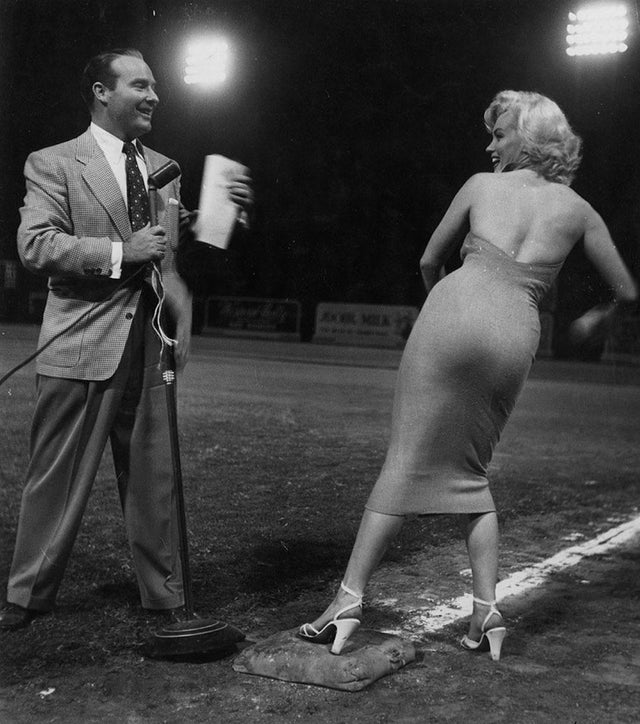
Marilyn Monroe presents a large target for throws to first at Gilmore on Sep. 15, 1952 for a charity game. Tony Curtis' squad defeated Desi Arnaz's team, 8-4. |
After the Stars won the pennant in 1952, Branch Rickey, now the the general manager of the Pittsburgh Pirates, hired Fred Haney to coach the last-place Pirates in the majors, then tapped catcher Bobby Bragan as a player/manager for the Stars. Cobb was originally against the choice, thinking that Bragan's personality was the wrong fit for the more urbane, cosmopolitan Stars (e.g., a team known for wearing shorts). But he let Rickey talk him into it, and was Cobb ever glad to be wrong.¹º
Bragan played in ninety-eight games for the Stars in 1953, and led the team to their second consecutive pennant. After the season, The Sporting News named him its Minor League Manager of the Year, noting the players were "inspired by Bragan's fighting leadership." (Sporting News, December 30, 1953.)
Bragan was a truly colorful baseball character, who took delight in both torturing umpires and entertaining crowds. A photograph of Bragan lying at the feet of umpire Emmett Ashford, who had ejected him, still arguing, was published in Life magazine as the "Picture of the Week". Bragan may not have been as polished as Haney, but he was a showman, and Hollywood loved him.
In 1953, Bragan was tossed from a game against their other Southern California rival, the San Diego Padres, after slamming his chest protector to the ground to protest what he considered some bad calls by the umpire. Ordered to pick up his equipment, Bragan refused and instead proceeded to remove his shin guards, mask, glove, and cap. Banished to the dugout, he added his uniform top, shoes, socks, and a few towels to the pile. Bragan and the Stars survived the ensuing fine and suspension to win the pennant handily.¹¹
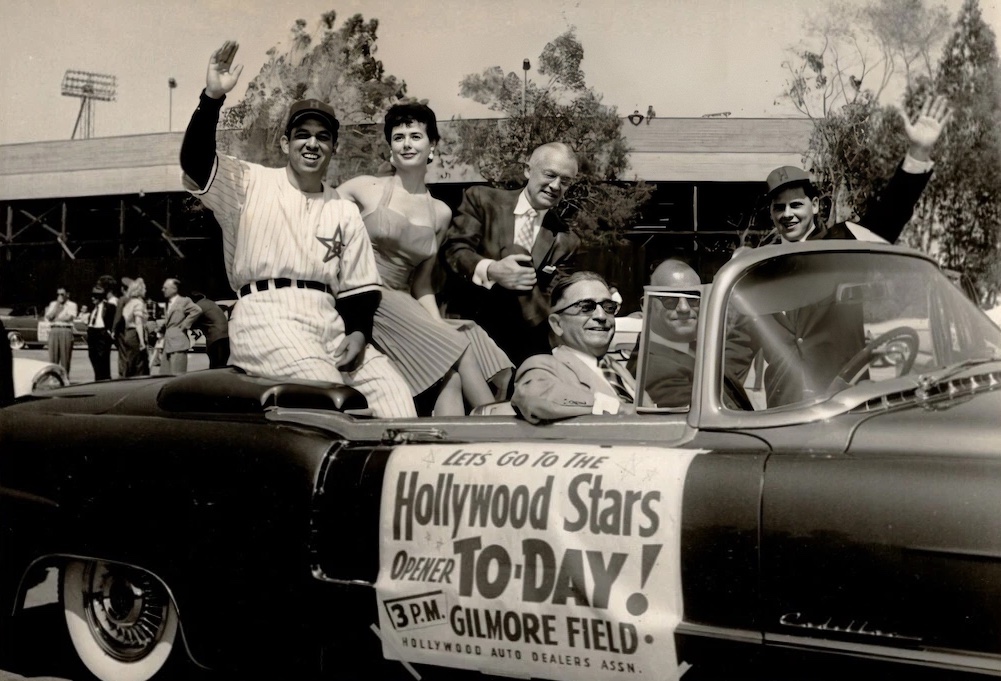
During another game, the Stars fell so hopelessly behind the Angels that player-manager Bragan, who liked to smoke long black cigars through his catcher's mask, sent nine pinch-hitters (mostly pitchers) in for one batter, running in a new hitter for every pitch (Bragan was suspended, even though he pointed out that the tactic was legal).
The Stars and cross-town Angels, who seemed to win the pennant every other year, would brawl every time they played. Angels manager Bill Sweeney once offered a cashmere suit to the first player to start a fight with the Stars. Angel infielder Gene Mauch almost won when he "sort of walked all over" Carlos Bernier, who had just slid into second base—but Sweeney decided that Mauch had taken too long to instigate the fight. Mauch and Bernier fought more than once—Mauch, who would go on to become one of the nicest MLB managers who ever lived, delighted in scooping up sand in his free hand to throw into Bernier's face every time the Star would steal second.
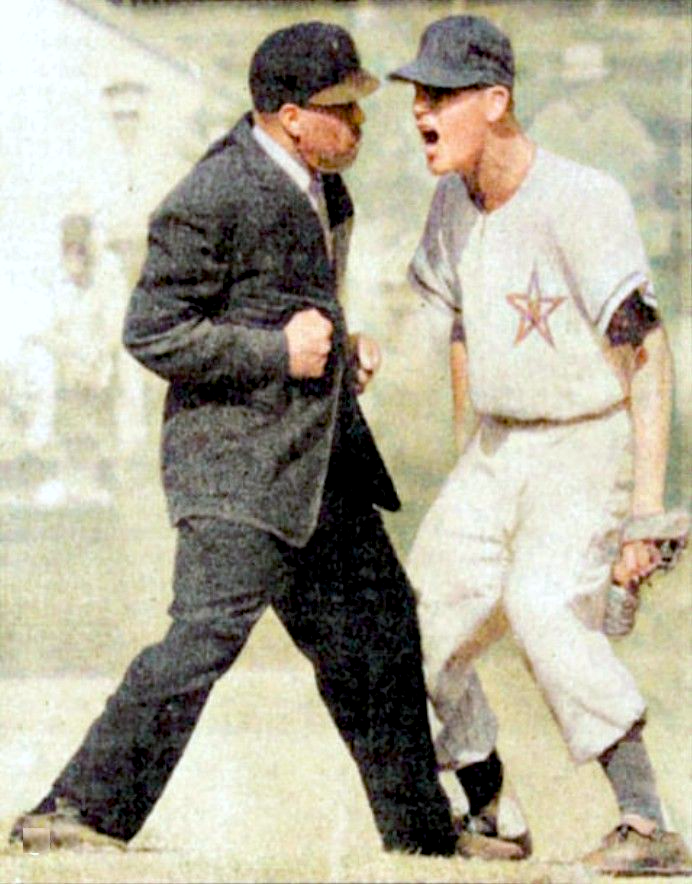
"They can yell 'kill the umpire,' but they can't kill me!" |
Jack Wayne Lohrke was a utility infielder, catcher and pitcher for the Stars who went by the nick-name of "Lucky." Normally you would think a guy named "Lucky Lohrke" would just be called that because the nickname sounded similar to his surname... but you would be wrong—many times over. Lohrke originally signed with the Padres of the PCL out of high school, but World War II intervened. He boarded a troop train that crashed and killed three men, but he walked away unhurt; He then survived the chaos and carnage of the Normandy invasion and the Battle of the Bulge, while the soldiers fighting next to him were killed on four occasions. At the close of the war, he was trying to fly home but was bumped from the aircraft when a higher-ranking officer took his seat. Naturally, the plane then crashed, killing everyone on board. In 1946, Lohrke resumed his baseball career with the Class B Spokane Indians, but death still chased him. On June 24, he was on the team bus when he learned that he was being recalled to San Diego. Lohrke removed his gear from the bus and hitch-hiked back to Spokane—and the team bus subsequently broke through a guard rail on a mountain pass, and plunged an estimated 300 to 500 feet into a ravine, killing nine people. The "Lucky" nickname was then given to him in San Diego. Fortunately he was lucky and talented, so he was promoted to the majors (it can be noted that there were no fatalities). Finally the Pirates sent Lohrke back to the PCL with the Stars for the 1954 season when Branch Rickey was packing Hollywood with players for another pennant run. After his baseball career, he apparently missed having near-death experiences and worked as a security guard, of all things, at Lockheed. He had a stroke at the age of 85, surviving for two days in a San Jose hospital—and it's a good bet that no patient wanted to take the bed next to his in the ER—but it was finally Lohrke's turn to be the unlucky one, and he passed away in 2009. |
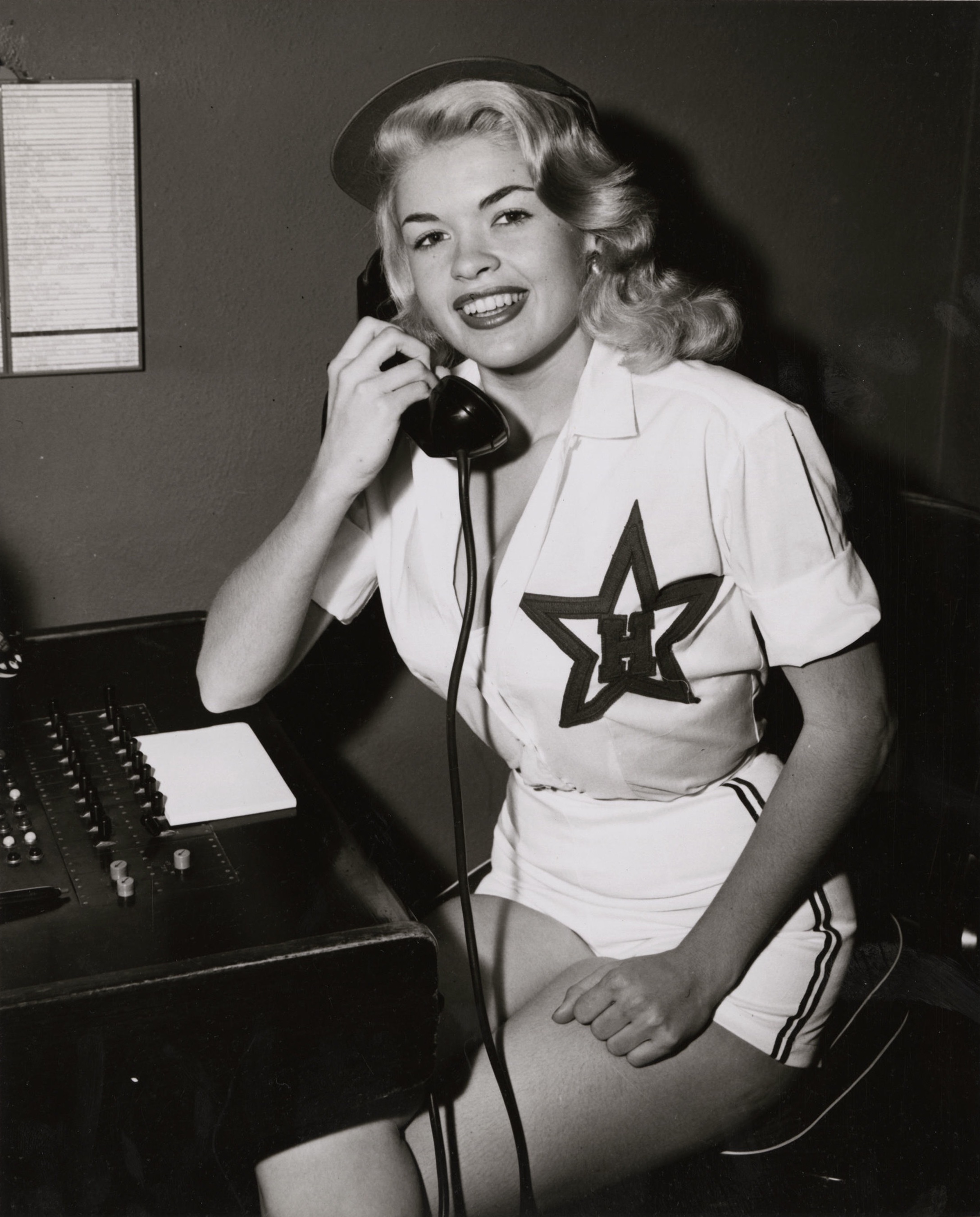 |
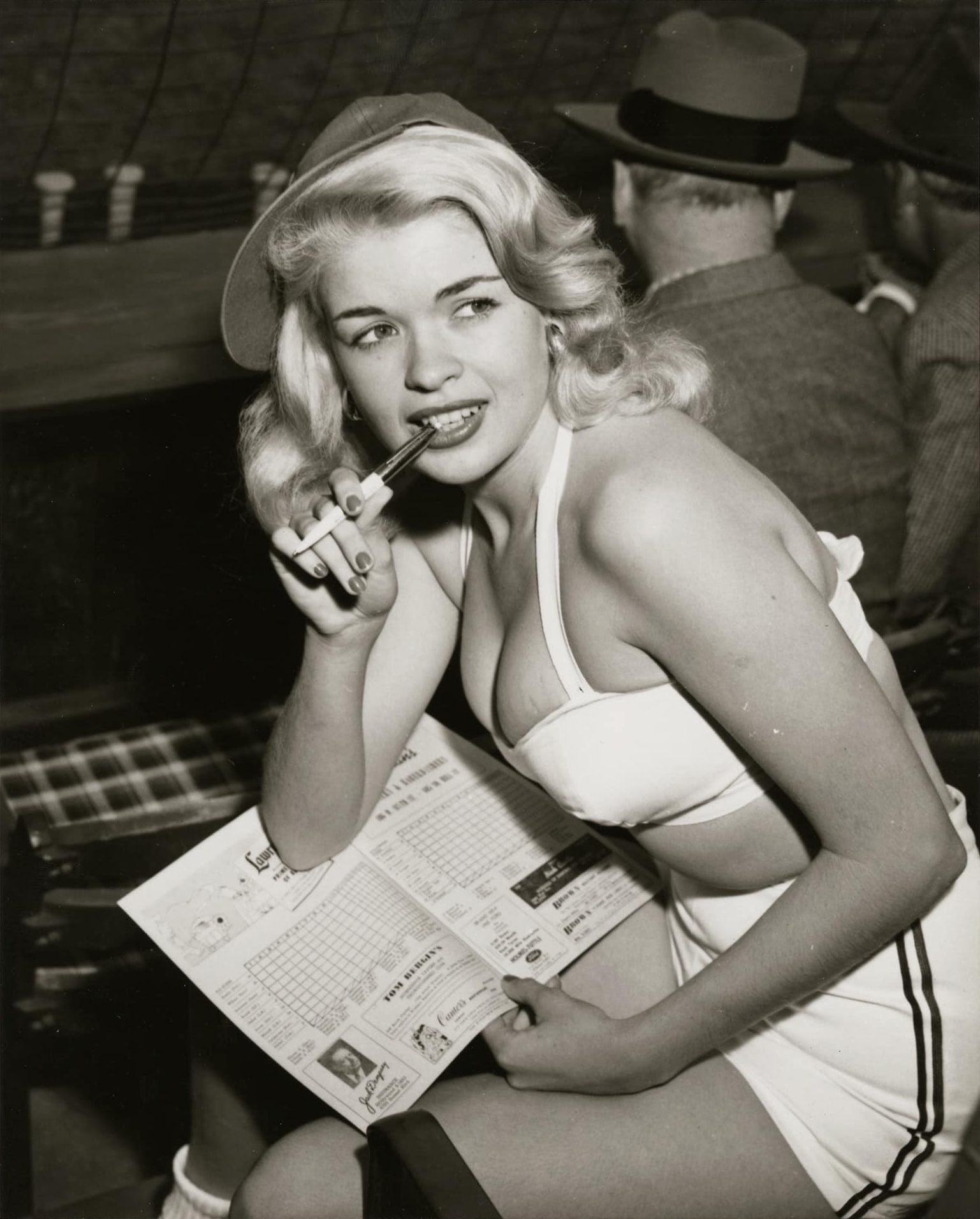 |
The Stars grew more popular as they continued to win pennants throughout the fifties. If that didn't bring the Stars enough notoriety, CBS Television City, a $7 million studio complex opened next door on November 16, 1952, where Gilmore Stadium once stood at the corner of Beverly Boulevard and Fairfax Avenue—so TV stars attended the games every night after work. (And sometimes their characters even rooted for them: William Frawley's character on "I Love Lucy," Fred Mertz, bemoans that the rain has caused him to miss a Hollywood Stars game in the season four episode "In Palm Springs," in 1955.) Jayne Mansfield was "Miss Hollywood Stars" of 1955. When she jogged (or should we say jiggled) out of the dugout, the male fans all howled and moaned—and as she stood at home plate, her breasts higher and tighter than a Ben Wade fastball, all those clichéd sex/baseball analogies suddenly made sense. Other "Miss Hollywood Stars" winners included actresses Betty Underwood in 1950, Marjie Millar in 1952, Kathy Marlowe in 1954, Pat Sheehan in 1956, and Julie Reding in 1957. If the stars of "Female Jungle," "The Girl Can't Help It," "A Dangerous Profession" and "Girl with an Itch" were too lurid for your taste, a teenage Elizabeth Taylor served as a bat girl for charity games.
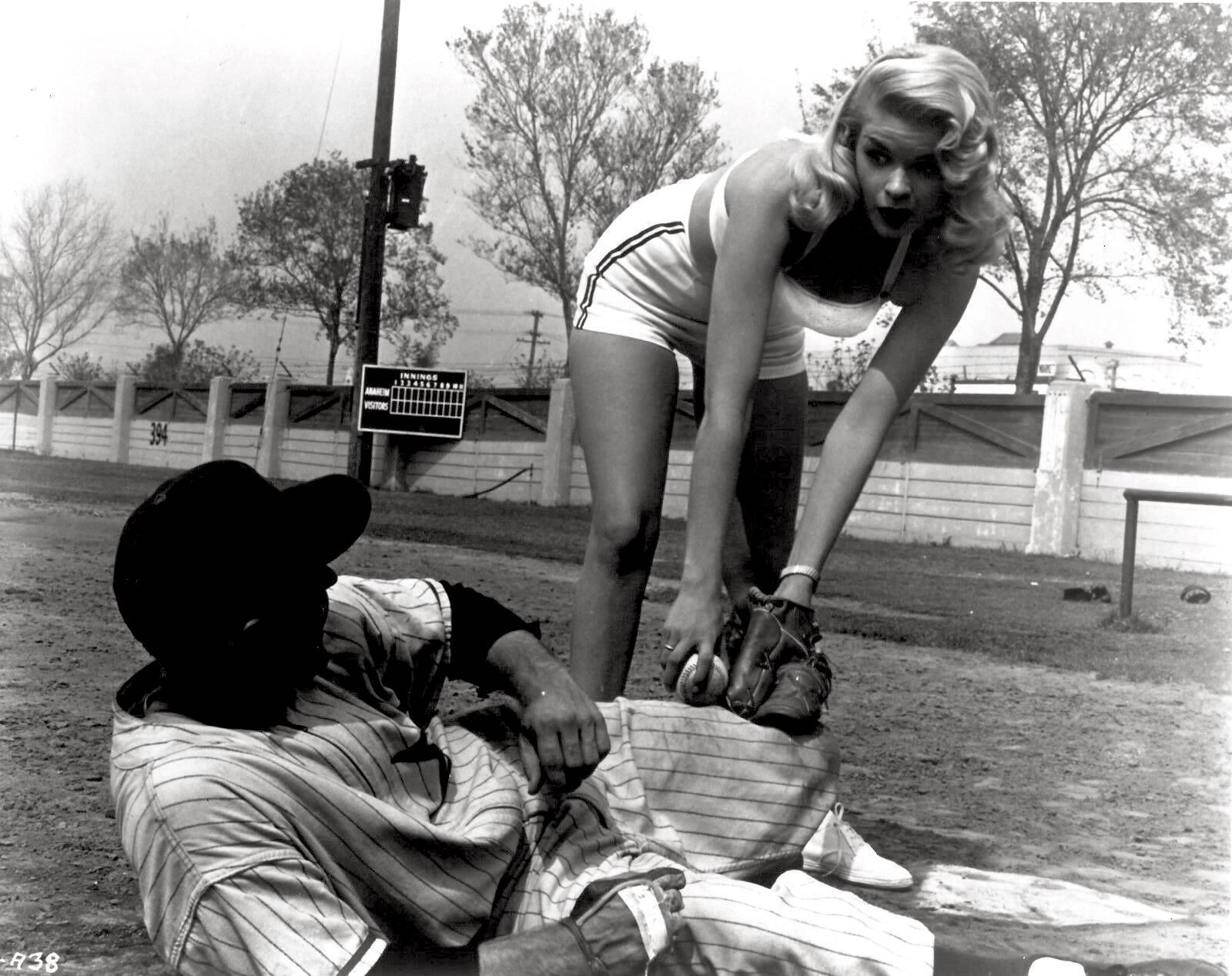
But all was not well with the rest of the league. By the 1950's the attendance at PCL games began to drop off, when Mutual Radio began to broadcast a Major League Game of the Week. In 1950, the attendance fell by 15 percent from the previous season. The next season was even worse. The 1951 season saw a 30 percent decline, from 3.1 million to 2.2 million. The Stars were affected as well, as there were now half a million TV sets in Los Angeles and station KTTV was airing every home game and generating hundreds ouf thousands of dollars in ad revenue as stadium attendance dropped. Broadcasts were then limited to Friday nights and the second game of Sunday double-headers. But this situation did not stop the PCL owners from dreaming of major league status.
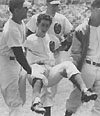 |
Oakland Oaks rookie Billy Martin, covered in blood, was carried off the field in a game against the Stars. A baserunner spiked Billy in both legs at second base. In the dressing room, a doctor called in from the stands gave Billy a shot of whiskey, and trainer Red Adams and teammates held him down while the doctor stiched up the wounds without the benefit af any anesthetic. |

Branch Rickey and Bob Cobb in 1954. (The Billings Gazette, Billings, Montana; 01 Jul 1954; Page 19. Click to enlarge) |
Despite this, Branch Rickey still wanted to preserve his deal with the Stars, even though with the AAAA rating such agreements were now prohibited. So Rickey pulled a legally-questionable move by approaching Stars investors and buying up a one-sixth share of the team. The PCL objected loudly, but Rickey claimed he was just investing in a great baseball team, and the MLB Commissioner let the transaction stand, but the Stars were beginning to resemble a more traditional farm team for a major league club than "the Hollywood Stars, owned by the stars." An era was ending. This became even more clear when after Lods Angeles missed out on attracting the Braves and Athletics, who had moved west to other cities. Los Angeles Mayor Norris Poulson was so hounded in the newspapers for not landing a major league ballclub that he held a press conference to announce that the city indeed had a plan to accomodate a big league team... and held up Bob Cobb's plans for a modern stadium at Chavez Ravine, claiming it as his idea.¹² It was then that Cobb knew the Stars' days were numbered. He began looking into Phoenix as a possible destination for his club, where he had optioned a Class C minor league franchise, the Phoenix Senators, renaming them the 'Stars' and using them as a farm club in 1954 and 1955. But the idea fizzled and relations were severed.
|
THE BRAWL: During a Stars/Angels series at Gilmore Field in 1953, the greatest professional baseball fight of all time occurred in the sixth inning of a hotly contested game. Stars and Angels pummeled each other for about half an hour—to the delight of the fans and the local television audience—until Los Angeles Police Chief William Parker, watching the fight on television, called in every available police unit to Gilmore Field. Fifty police officers swarmed onto the field, into the melee. After half an hour of fighting, order was finally restored. Cops were stationed at each clubhouse, and only nine players were allowed outside at a time. They had to do it that way—it was a doubleheader, and another game had to be played! (For newspaper accounts, click here.)
|
The star Star, Frankie Kelleher, left baseball in 1954 and his number 7 was retired by the team. The crowd gave him a grateful standing ovation for ten years of baseball thrills. Jayne Mansfield cried.
After Hollywood finished second in 1954 and third in 1955, Rickey hired Bragan to manage the Pirates for 1956. Although Bob Cobb continued to determine club policy, it was apparent that the community-based leadership (the "Hollywood Stars baseball team, owned by the Hollywood stars") was gone, and that the Stars were just becoming a development team for the Pirates. Eventually, Rickey even became the Stars' Chairman of the Board after Victor Ford Collins passed away, and there were many changes in the front office (although Cecil B. DeMille was asked to stay on in an honorary capacity). Through all of that, and despite nationwide MLB game-of-the-week radio and TV broadcasts, things were looking up for the Stars under Rickey's leadership...
... Until the death knell sounded for them—and the rest of the league—when MLB allowed the transfer of the Brooklyn Dodgers to Los Angeles and the New York Giants to San Francisco after the 1957 season. The call for an MLB team had grown louder throughout the fifties as cross-country transportation became quicker and cheaper. When Dodger owner Walter O'Malley visited Los Angeles to find a venue for his team, he didn't want to talk to any city planners or politicians; he said he would only speak to Bob Cobb. Most people who've just had their business taken away and their dreams dashed would have angrily refused to meet, but Cobb graciously brought O'Malley his plans for a stadium in Chavez Ravine and sold him on building a modern stadium... and the Dodgers found a new home. Ever the baseball lover, Cobb even bought season tickets (although he switched allegiences a few years later when Stars fan Gene Autry created a Major League team of his own called the Los Angeles Angels).
With major league clubs now playing on the West Coast and fan interest switching to the larger leagues, the PCL could not compete. Its teams were summarily dropped back to AAA status by MLB, and became a group of traditional farm teams again (there has never been another "AAAA" league since). So even though the league survived, it never regained its previous popularity. The Coast League became just another minor league, and its stars could be moved up to the majors as the parent club saw fit.
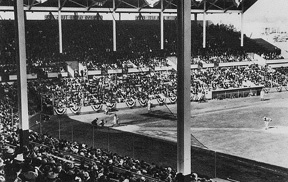 |
The Stars found themselves unable to compete with the publicity juggernaut that was the Los Angeles Dodgers. (Owner Walter O'Malley actually bought the rival Los Angeles Angels outright, and exiled them to Spokane, Washington, as one of their farm teams.) Attendance plummeted in Hollywood. Mexico City and Phoenix made offers to buy the team, and for a while there was talk of moving the Stars to Blair Field in Long Beach, but the PCL preferred that the team move north, closer to homes of the other teams in the league. The balance of power in the league had shifted from California to the Northwest. Cobb's idea to relocate the team to Phoenix had fizzled when the Phoenix Stars club was purchased by the owner of the San Francisco Seals, taking away the territorial rites.
Ex-Dodger pitcher Clyde King closed what would be the Stars' last season in Los Angeles by leading Spook Jacobs and a crew of Pirate projects and rejects to third place in the PCL.
 |
The Stars/Angels feud continued through the clubs' very last days in Los Angeles. In 1957, Angel southpaw Tommy Lasorda threw high and tight on Hollywood Star Spook Jacobs, knocking Jacobs down into the dirt. Jacobs bunted the next pitch up the first base line... because he knew Tommy would have to cover first, and he wanted revenge. Tommy didn't even wait—instead of fielding the ball he tackled Jacobs on the way to first and they began swinging. The now-traditional brawl followed (actually three at the same time, in various parts of the field). Jacobs battled Lasorda, and then the entire Angel infield, including Sparky Anderson, who grew up in Los Angeles and had been a batboy for the Stars. Sparky sprinted into the fray from his position at second base, and was pictured the next day in an AP Wirephoto ducking under a haymaker from Jacobs. "It looked like I knocked the you-know-what out of him, but I had missed him completely," Jacobs said. Thirty minutes later, the umpires were able to restore order (without the cops this time). (Los Angeles Times)
|
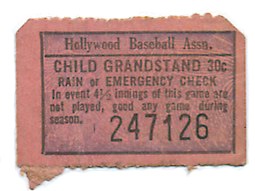 |
The last Hollywood Stars game was played at Gilmore Field on September 5, 1957, before a crowd of 6,354 diehard fans. They cheered the Stars on to a 6-0 victory over the San Francisco Seals. Jayne Mansfield presented Bob Cobb with a new car before the game as fans gave him a standing ovation. "These years with the Stars have been the best of my life," he said as he held back tears. As for the game, Hugh Pepper threw a no-hitter for 8 2/3 innings against the champion San Francisco Seals... before a fly ball fell in front of center fielder Bernier in the ninth, and the Stars broke their fans' hearts one last time.
|
The Stars weren't just good for the community—they were the community. Second baseman Lou Stringer and catcher Eddie Malone sold Chevrolets during the day. Pitcher Roger Bowman had an upholstering shop in nearby Santa Monica. Irv Noren ran a bowling alley. Less successful was coach Harry "The Horse" Danning's Hudson dealership in Culver City. (Getting paid seven grand a year for playing baseball doesn't mean you don't have to work for a living.)
|
 |
'57: STARS FALL |
On December 5, 1957, Utah businessman Nick Morgan finally purchased the Stars franchise for an estimated $175,000 and moved it to Salt Lake City—the city which had relocated its franchise to Hollywood in 1926. Utah finally got its "Salt Lake City Bees" back.¹³
After 19 years, Cobb lost money the team. "The stockholders haven't got their original investment back yet," he lamented—although most of the original Hollywood stockholders were long gone (Cobb's ex-wife Gail Patrick, now the producer of the Perry Mason TV show, was still involved¹⁴). "I borrowed from Pittsburgh to pay off Victor Ford Collins and George Young when they wanted to sell their stock," said Cobb. "My purpose was to get a respectable club for Hollywood by tying up with Pittsburgh. It worked out very well. We won three pennants end tied for one, were second twice and third once in the years we've been associated with Branch Rickey."
Some were campaigning in the press for Cobb to get a high position in the Dodger organization. 'I'm not seeking any position anywhere,' he said firmly. "I've had a business for 40 years (the Brown Derby) and I love and am proud of it." Still campaigning for Chavez Ravine, he said, "I don't want to be a big shot in baseball; I just want to give L.A. the best recreation center in the world."¹⁵
"Friendly Gilmore Field" was torn down in 1958. The field lights were sold to the Dodgers' newest AAA farm team for their stadium in Spokane Washington: the hated Angels, who had been relocated from Los Angeles and renamed the Spokane Indians! The lights are still being used today at Avista Stadium.
Because it was Hollywood, after all, when Gilmore Field was demolished, they used the event to film a TV show, called Rescue 8 (the episode is titled "Ferris Wheel"):
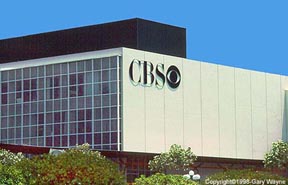 |
Much later, Los Angeles Times columnist Alan Malamud wrote: "For four or five years after the Dodgers came, I had this dream that there was still a PCL team at Gilmore. Every time I woke up, it killed me to find out I couldn't go to a game there." The soundstages of CBS Television City now stand in Gilmore Field's place. The only evidence of its existence are a few palm trees from the parking lot and a plaque attached to the front wall of CBS Studio 46, where the front entrance of the park was located. The plaque offers two photographic views of the field and commemorates the 1700 games of professional baseball played there (Bobby Bragan himself attended the dedication ceremony in 1997. There were no fights).
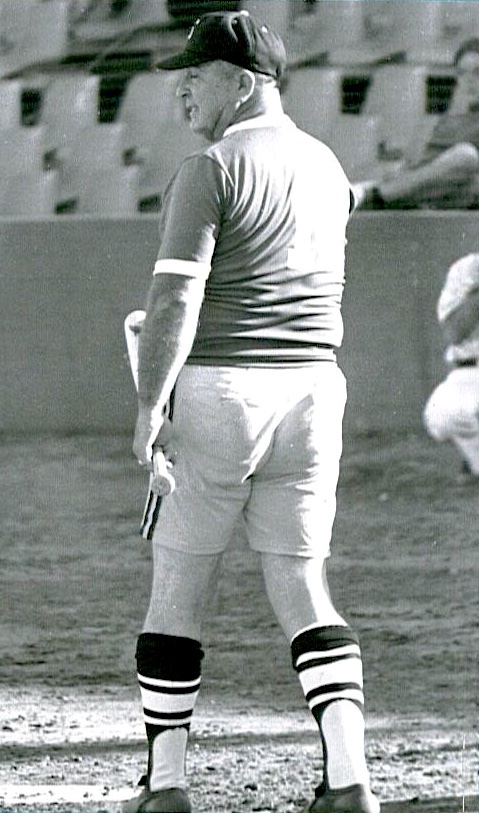
Another enduring legacy from the Stars: An elderly Frank Kelleher takes batting practice in Sacramento, and... the shorts live!!! |
The Salt Lake City Bees moved back and forth between the revamped PCL and smaller Pioneer League, and then finally were relocated to Washington in 1965—becoming the Tacoma Rainiers (they are owned today by the Seattle Mariners). Bob Cobb himself was involved in the Pioneer League, but on a different team. Since 1948 he had owned the Billings Mustangs, in his home state of Montana, using them as a farm club for the Stars. He employed many of the same methods to build that franchise that he had developed with the Hollywood franchise: gathering support from local celebrities and investors,¹⁶ and even building Cobb Stadium, a entertainment-based sports structure like Gilmore Field. But Cobb ran it from afar; he partnered with Archie Cochrane, brother of Hall of Famer Mickey Cochrane, so that he could stay in Hollywood and run his beloved Brown Derby. (Bill Frawley finally got his wish, with Cobb bringing in Mickey Cochrane to run the team!)¹⁷
Today the Tacoma Rainiers are just an ordinary minor league development team, with no movie stars in the stands, no parades, no bat girl who happens to be Liz Taylor, no Gilmore Field—just a rainy place that players hope will be a short stop on the way to a more exciting destination in the majors.
You can't have Stars without Hollywood.
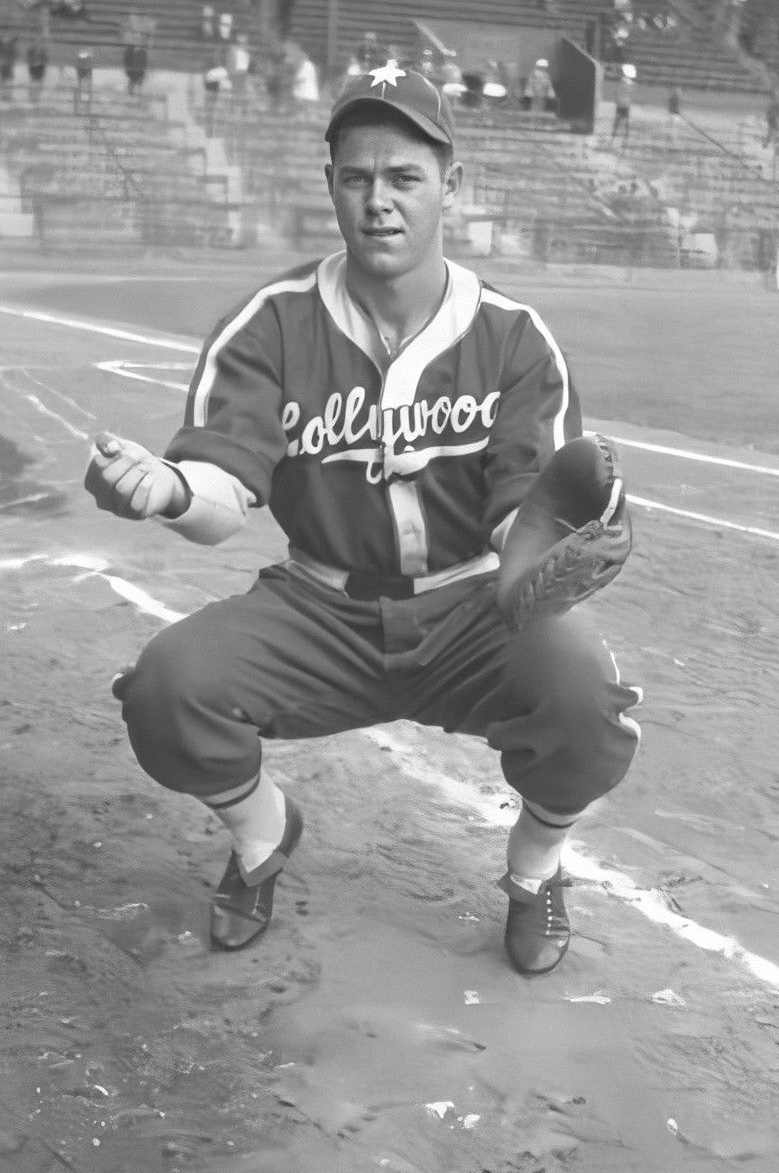 |
A shout out to the family of Cliff Dapper (1920-2011), whose history as a catcher and coach intertwined with the Stars over three decades: First as a catcher from 1939 to 1941 before being called up to the Dodgers; then after war service he signed with Hollywood again from 1950-51. Dapper then became the player/manager for Cobb's Billings Mustangs from 1952 to 1955. When the Stars moved to Salt Lake City, Dapper was their first manager. After baseball, he moved to Fallbrook CA, a few miles from this author, to raise avocados with Dodger pal Duke Snider. RIP Catcher, Coach, and Avocado Growers Council President! |
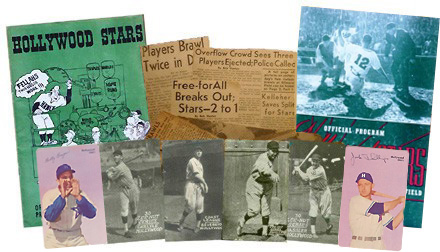
Click on the collage to view Image Gallery.
|
NOTES ON THIS PAGE:
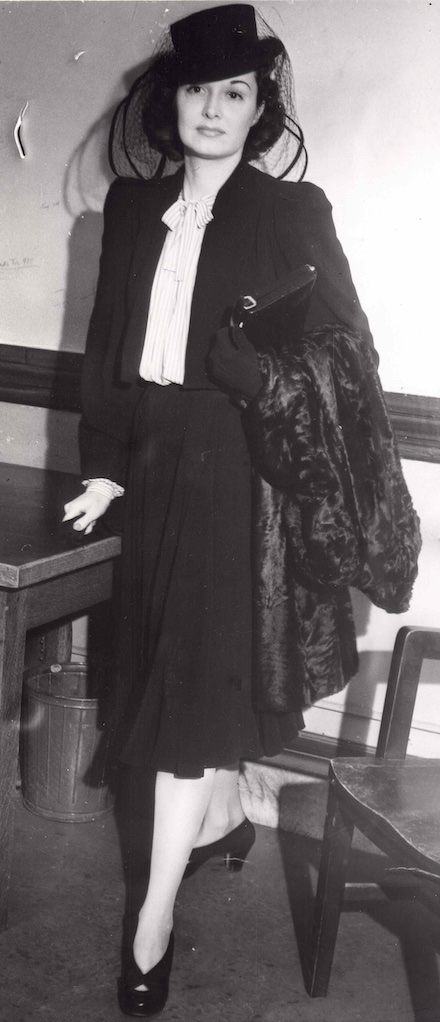
This is when you know you're about to get rolled in the divorce: Your wife poses for glamour shots outside the courtroom in a special black divorce outfit, with matching hat, veil and mink. |
¹—"In the Spotlight," Hollywood Citizen-News, Wednesday, April 16th 1941, page 15. "Gail Patrick Files Suit for Divorce From Cobb," Los Angeles Times, 29 October 1940; Page 23). Now, about the divorce: Without trying to blame the victim here, I submit that being married to a film goddess, and a truly driven, ambitious and impressive person like Gail Patrick (over 60 movies, law degree, aspiring politician, vice president of the National Academy of Television Arts and Sciences, president of its Hollywood chapter, twice named Los Angeles Woman of the Year by the Los Angeles Times) was a third full-time job that Cobb could not keep. Patrick was married three more times after her divorce from Cobb. The second time was at the end of World War II to Navy Lieut. Arnold Dean White, a flyer who she met in 1944 at a War Bonds rally and married two months later. White was so anxious to marry her that he AWOLed from his Navy base, was caught, and confined to "bachelor's quarters" for two weeks; Patrick then had still-born twins and they divorced a little over a year later. In that case, which Patrick claimed was also due to "mental cruelty," she charged that the union "frequently was beclouded with arguments antagonism and public embarrassments" (The Bristol Herald Courier, Tennessee, 26 Mar 1946, Tue; Page 5). She testified that White was molesting her in his try for a reunion at any cost, and that he broke into her home at 1:30AM and endangered "her health and career." Patrick's third marriage/divorce was to advertising executive Cornwell "Corney" Jackson, who she dragged to all of the Stars games (as seen here in The Sporting News with Ginger Rogers and her husband), and with whom she formed a TV production company that made the Perry Mason and Lassie shows... and then adopted two children. When they divorced she said they "didn't get along" and "had conflicts because he did not believe in disciplining the children and we had conflicts on religion because be claimed to be an atheist." She also said her diabetic ailment was made worse by her husband's actions. (Did I mention that she was the first national chairman of the American Diabetes Association board of directors?) Patrick married her fourth husband, John E. Velde, Jr., in 1974. She died from leukemia six years later, at age 69, at her Hollywood home of more than 30 years. She had been treated for the disease for four years, but kept her illness secret from everyone but her husband. Though she split with Cobb she never left the Stars, keeping her stock in the team and her box seat near the home dugout at Gilmore Field, from which she hosted a post-game TV show in the early fifties, and remained the Stars' biggest fan. Interestingly, she was represented in the divorce from Cobb by attorney Victor Ford Collins... the President of the Hollywood Stars.

Ford Frick (NL President), Happy Chandler (MLB Commissioner) and William Harnidge (AL President) deny the request of PCL President Rowland (2nd from left) to admit the PCL as a 3rd major league. The swift kick in the pants they gave Rowland probably gave him his nickname. |
²—"Rickey Says Major Ball for Coast Long Way Off," by Al Wolf, The Los Angeles Times, Los Angeles, California; 06 Dec 1946, Friday; Page 10. "There are many questions that must be satisfactorily answered if the Pacific Coast League is to become a major league," Rickey pointed out. "Do the parks have enough seating capacity? Can the league meet present major league salary totals? Are the actual or potential populations sufficient to support major league ball? Would major league status be fair to the players, who then could not enter the National or American league via the draft?"
³—"PCL Asks Major Status Today," UP, The Times of San Mateo, California; 07 Jul 1947, Monday, Page 9. Okay, folks, here's a real deep-dive that nobody asked for, and doesn't fit into the narrative of this article: During the 1943 offseason, PCL owners elected Clarence "Pants" Rowland league president. "Pants" is probably the second tragic hero of this story, after Cobb; He was a baseball lifer, having outlived a (bad) playing career, the Black Sox scandal, and the Great Depression to stick in pro baseball, and the PCL sought his expertise as they were trying to survive the loss in players and attendance due to World War II. Rowland felt the time was right to merge with the leagues in the East. He knew that eventually the major leagues would have to accept the population shift in the country and move west, and he thought the PCL could facilitate that with existing competitive teams (they often beat the NL and AL teams in exhibition games when the Eastern franchises came out west for spring training). Pants mounted a drive to win recognition as the third major league; a rival to the AL and NL, so they could prosper in the post-war economy. "This is big-league territory," Rowland said. "We have big-league fans and big-league players and a big-league population." When World War II ended, Rowland formally petitioned for major status at the 1945 winter meetings. The majors turned him down flat. For one thing, MLB Commissioner Kenesaw Mountain Landis remembered Rowland as the manager of the Chicago Black Sox (Pants was fired the season before the scandal, saving his career), and didn't trust or respect him ("Between the Sport Lines," by Wilbur Adams, The Sacramento Bee, 17 Jun 1947, Tuesday; Page 18, column 1). Besides, those markets were obvious destinations for any major-league team looking for a more profitable home, or for an expansion team. That posed a mortal threat to the PCL's survival. Rowland, however, kept the pressure on.
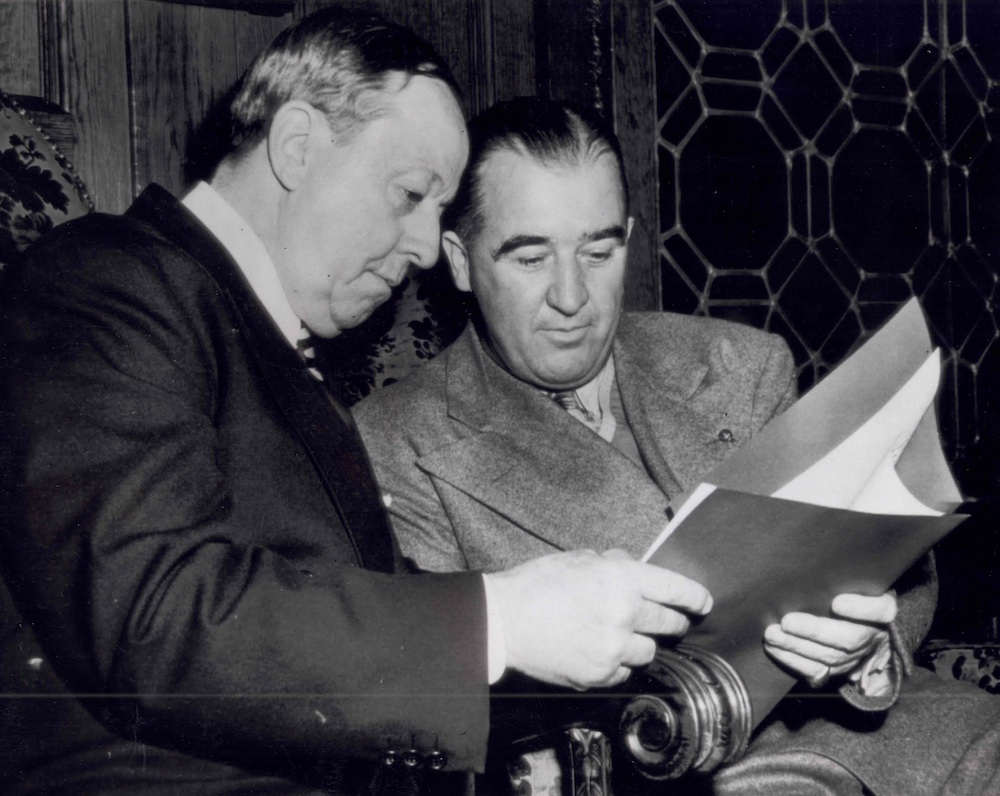
"The script goes, 'You're Happy, I'm Pants. What's the guy's name on first? I don't know. He's third base..." (Actually Rowland is showing Chandler yet another PCL request to join the major leagues, which resulted in a special "open" (AAAA) ranking for the league.) |
In 1947, the new MLB Commissioner, Happy Chandler, led a delegation to meet with PCL owners in San Francisco. ("Hi, Happy, 'bye Mountain, I'm Pants"... don't you miss good baseball nicknames? This reads like a Bazooka Joe comic.) NL President Ford Frick (sigh... not even a nickname) recalled, the major league owners scared the Westerners by showing them the costs of operating a big-league club: "Immediately two or three of those [PCL] men said, 'Good Lord, we cannot be major league.'" (Source: Hearings Before the Subcommittee on Study of Monopoly Power of the House Committee on the Judiciary, 82nd Congress, First Session, Serial No. 1, Part 6: Organized Baseball; Washington: Government Printing Office, 1952; page 99.)
The PCL owners were divided on how to move forward. The teams in Los Angeles and San Francisco—especially Cobb—craved the big-league label. However, the more remote, less-populated areas of the circuit—such as San Diego, Sacramento, Portland, and Seattle—balked at the cost, and believed only the teams in the biggest cities could survive. A major league park could typically hold 40,000 fans, while Gilmore Field, for instance, could only hold 12,000—which is why Cobb started looking to Chavez Ravine to build a bigger facility...
⁴—"Arguments Stress Need For Big League Park", AP, Pomona Progress Bulletin, 17 December 1954. "Robert, Cobb, president of the Hollywood Stars, urged the building of a big sports center at Chavez Ravine, adding, 'It would be a mistake to make over and rebuild Wrigley Field.' The council is considering a 40 million dollar bond issue for park and playground development." Unfortunately for Cobb, the city ignored his request, holding out for an established major league team to move west. With the new threat of the Majors moving into the west, or creating an expansion club, Rowland was unable to find the financial backing to bring both PCL facilities and teams up to major league standards. As an interim step, Rowland pressed to make the PCL exempt from the draft, which had allowed the majors to rob the league of its best players for just $7,500. He believed that if the teams in the PCL could hold onto their talent (Joe DiMaggio, Ted Williams, Bobby Doerr, Tony Lazzeri, for instance), then the PCL could rival the quality the Eastern Leagues within five years. The majors fought this because they didn't want to give up a cheap source of players and dilute the talent level in their league... but as a compromise agreed to increase the draft price to $10,000. Rowland wasn't satisfied, saying, "We don't intend to continue as a kindergarten for the major leagues." (Associated Press, "Rowland Gets Turned Down Sixth Time," The Los Angeles Times, 12 Jul 1950, Wednesday, Page 56.)
An obvious answer for the PCL was to "go outlaw" and raid the majors for players. The Angels and Stars were already competitive with and even outspending the majors on some talent (for instance, when Steve Bilko of the Angels was called up to the majors in the late 50s, he had to take a pay cut), but the smaller PCL owners and even the once-mighty Seals had no appetite for an expensive salary war with MLB. They considered a less drastic move: a declaration of independence. At a meeting in September 1951, Rowland led the charge of the club owners, who voted to serve an ultimatum on the majors. If they did not receive an exemption from the player draft, the PCL would declare itself the third major league, operating as an "outlaw" league. They would withdraw from the major-minor league agreement, and from the draft, but respect the majors' contracts. When they took a vote, the owners deadlocked, 4-4. In view of the split, Rowland declined to break the tie. ("Coast League Outlaw Plan Fails to Carry," Los Angeles Times, July 28, 1951: 3-1) Still, the vote got the majors' attention. At the 1951 winter meetings they created a new "Open" (AAAA) classification, a step above Triple A. The PCL was the only league to qualify. ("Majors Approve Open Classification," Los Angeles Times, December 10, 1951: IV-4, p. 88.) The majors made additional concessions: Players would be eligible for the draft after five years in the Open class rather than four; Open teams would be paid $15,000 for a drafted player; and a player could opt out of the draft with a special 'yellow' contract, giving PCL clubs an opportunity to buy the loyalty of their stars with bigger salaries.
The majors held out the possibility that an Open-class circuit could be granted big-league status if its population, attendance, and ballparks met certain criteria. Rowland declared that the new arrangement "ultimately will bring major league baseball to the Coast." Other observers thought it was just a stall tactic by the majors. It was in fact an all-or-nothing moment for the PCL owners, and they hesitated when they could least afford it ("PCL Voids No Option Rule; Rowland May Be Out As President," The Sacramento Bee, Friday, October 30, 1953). Six years later, the Dodgers and Giants invaded PCL territory, making Rowland's worst nightmare come true. Seeing the writing on the locker room wall, Rowland stepped down as PCL president at the close of the 1954 season to become a vice president—for the Chicago Cubs in the majors. ("Rowland Quits Coast League for Cubs," Chicago Tribune, November 19, 1954: C1.) Cobb also had a contingency plan, working around the "Open" classification to makee a deal with none other than...
⁵—"Brooklyn Boss Sees Stars Twinkle", Los Angeles Evening Citizen News, Hollywood, California; 15 Feb 1949, Tuesday; Page 22. "Here to talk over details of his recent working agreement with Hollywood's Stars, Branch Rickey (center) Brooklyn's head man, strikes a pose at the California club with Star Proxy Victor Ford Collins (left) and Vice President Bob Cobb. Rickey will head for Vero Beach, Fla., March 1 to look over rookies."
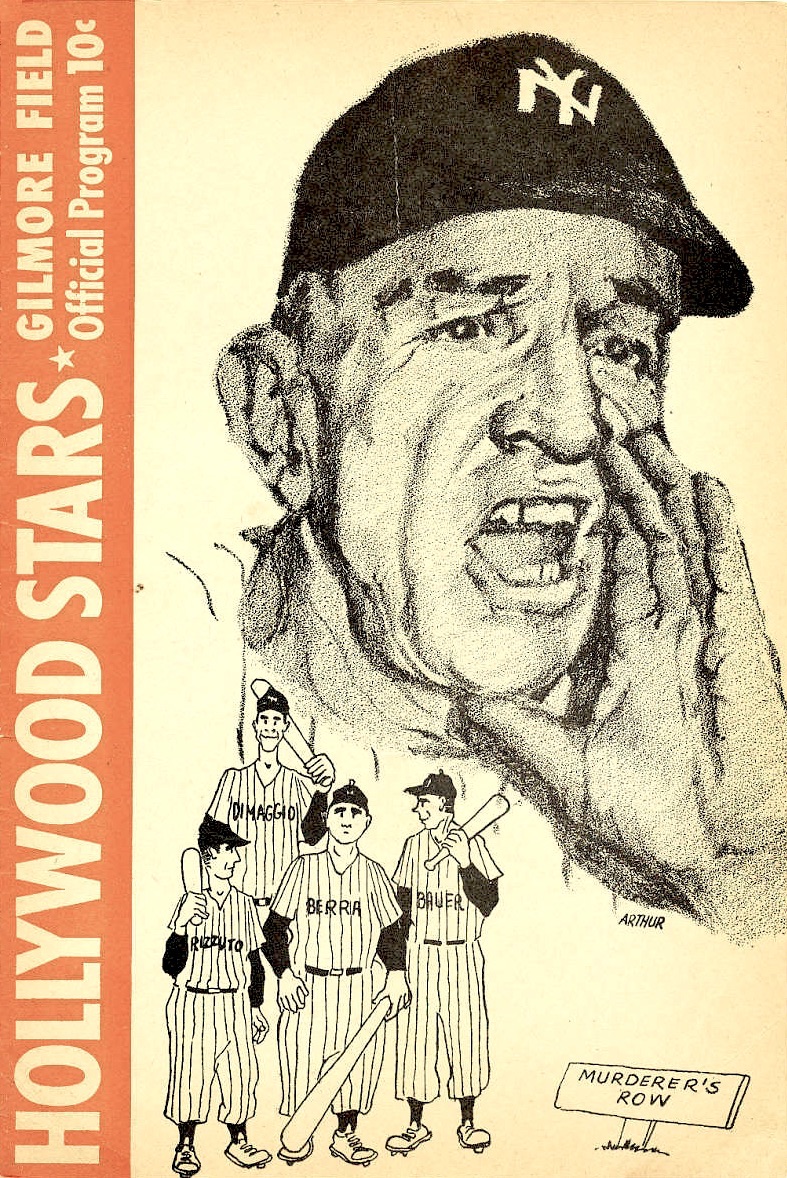
"You think you've won... but DiMaggio's taking Marilyn with him!" (Yankees lineup) |
⁶—The series was promoted in Los Angeles as the reigning MLB Champs versus the reigning PCL Champs. These would be the first games ever for the New York Yankees in California... and while the Yankees may have just thought of them as part of a preseason exhibition series, the Stars took their three battles very seriously as a means to show the baseball world that they could compete with even the best pro teams. Having just won back-to-back World Series, the Yankees featured Hall of Fame Coach Casey Stengel, 1950 MVP Phil Rizzuto, Hall of Famers Joe DiMaggio and Yogi Berra, and a promising rookie named Mickey Mantle. The chief Hollywood players with a point to prove were former Yankee pitcher Johnny Lindell, who was scheduled to pitch 4 innings in the opener, and Frank Kelleher, who hadn't been able to dislodge anybody from New York's All-Star outfield when trying to make the their team over several seasons in the Yankee farm system. Los Angeles Mayor Fletcher Bowron proclaimed Friday the 16th as "New York Yankee Day" and threw out the first pitch. An elaborate, large wooden collage display with framed photos from all 13 Yankee World Series wins was presented to the Bronx Bombers by "Miss Hollywood Stars" to commemorate their first games in California. (There's a photo of Kelleher forcing a smile while staring at it in the Citizen-News newspaper of March 14th). 150,000 fans were expected to attend the 12 games over the course of the Yankees' California tour. The Yankees and Stars went scoreless for eight innings in game one until the Yanks exploded in the 9th, when a walk by Lindell and an error set up a 2-run double by Cliff Mapes. More runs followed, taking the joy out of a solo homer by Kelleher in the bottom of the 9th as the Yanks won, 5-1. Kelleher also had a 3-run dinger in their next game on March 19th, which the Stars won easily, 6-3. According to The Fresno Bee, on 20 Mar 1951, Tuesday, page 25: "The Hollywood Stars smote the mighty New York Yankees 6 to 3 last night. It was only an exhibition game but the 11,259 local fans loved it.") The final game of the series went into extra innings, but the Stars pulled out the win, 4-3 in 10 tense innings. There was no trophy or championship ring, no fancy wooden collage display with championship photos, but the Stars felt they had proven themselves against the best team in the world (as did the papers)... Even better, the Yankees played the Angels twice in between Stars games, who they swept by scores of 9-6 and 13-4. (The Stars went on to beat the MLB White Sox the next night, 6-2).
⁷—"When Does Betty Grable Play First Base?" St. Louis Globe-Democrat, St. Louis, Missouri; 02 Apr 1950, Sunday; Page 52. "The Hollywood Stars gave the wiseacres a season's load of ammunition yesterday when they showed up in shorts. The cheese-cake exhibit above takes in, from the left, Pitcher Lee Anthony; Manager Fred Haney; Coach Rosey Gilhausen, to show how drab the old outfits are by comparison; Infielder Murray Franklin and Outfielder Eddie Sauer... Just before the game Manager Bill Sweeney of Portland burst out of the dugout and raced to home plaste to greet the scanty-panted Haney. Sweeney was wearing a flaring skirt and a grotesque lady's bonnet off his head. He carried a floor mop, and promptly embraced Haney, himself a gag-loving gentleman." "Hollywood Stars' 'Sexy' Shorts Fail to Draw Single Film Queen", by Virginias MacPherson (UP Hollywood Correspondent): Santa Maria Times, Santa Maria, California; 03 Apr 1950, Monday; Page 2. "Those skimpy new baseball shorts of the Hollywood Stars may have sex appeal but they didnt lure any movie queens away from their swimming pools. Not a single glamour girl showed up to ogle what manager Fred Haney said is the newest thing in baseball since Abner Doubleday invented the game 111 years ago. For the second day, the Stars trotted out on the diamond yesterday, flashing their knobby knees in their new blue-striped briefies. Over their manly chests they had clinging jersey tee shirts with the latest thing in short . sleeves. Their opponents, the Portland Beavers, wore the traditional heavy suits and dead-pan expressions."
⁸—"Stars' Boss Says Shorts To Stay Los Angeles", Ventura County Star Free Press, Ventura, California; 04 Apr 1950, Tuesday; Page 10. "Hollywood Stars shorts are here to stay. Manager Fred Haney of the Pacific Coast baseball league champions said the new uniform is no joke and will be used in all of the Stars afternoon games. 'Were deadly serious about this,' Haney said yesterday in a message to a meeting of Los Angeles sport writers."
⁹—"Groucho Marx Stars with Stars", Mirror News, Los Angeles, California; 24 Sep 1952, Wednesday; Page 69. "That was a championship party the Hollywood ball club threw for its championship team Monday night in the Mayfair Room of the Beverly-Wilshire. Groucho Marx pinch-hit for Bob Crosby as emcee and naturally hit a home run. He batted his eyebrows, rolled his eyes, and came up with a gag or a pun with every introduction. Groucho knew all the time the Stare would win the pennant, "How can you go wrong with a Rickey and a Collins," he chirped. (Branch Rickey is part owner of the club and Victor Ford Collins is president.) Bob Cobb, the executive boss of the Stars, brought his 81-year-old mother to the party. "I don't know how old Mrs. Cobb's mother is," Groucho orated, "but she's still young enough to play for the San Diego Padres." Manager Fred Haney tried to get away with a bow. "I think made my I speech about two weeks ago," he stated. "Make it over again," Groucho interrupted, "they weren't listening anyway." A mellowed Haney lauded his players and they lauded him, over the mike and on the side. It was from the heart stuff. Billy Schuster grinned: "It's the greatest club I ever sat on the bench for." Bonus Baby Paul Pettit got a laugh with his opening remark: "Well, I suppose you want to see my money belt." On the serious side, Pettit stated: "Next year I hope I'll not be with you because I want to be in the big leagues." But veteran Frank Kelleher, who senses time is running out on his career, hit a real sentimental note. "Every year I'm with Hollywood," he said with deep sincerity, "it gets better and better. I'd hate to see it stop." Chuck Stevens Joined the orchestra to beat the drum and Larry Shepard sang "Ol' Man River." Carlos Bernier did a rumba. He wants to comb back to Hollywood. "I love this place," he said expansively. When Groucho Introduced Red Munger, Red Lynn and Pinky Woods in a row, he looked startled. "Why, we're likely to get raided," he announced. Coach John Fitzpatrick played the piano and when the photog shot a pan of the party, he bellowed: "You can recognize me by the nose." Earl Gilmore, the oil tycoon, and his lovely wife would have won the blue ribbon for dancing. It went a long way through the night, a very wonderful baseball party." See also, "400 Whoop It Up for Stars at Big Victory Dinner", The Sporting News, St. Louis, MO; 01 Oct 1952; Page 32.
¹º—"Bobby Bragan Named To Manage Hollywood Stars", Visalia Times-Delta, Visalia, California; 07 Feb 1953, Saturday; Page 8. "Bragan In National Spotlight," by Chuck Sexauer (Innocent Bystander), Valley Times, North Hollywood, California; 06 Apr 1954, Tuesday; Page 11.
¹¹—"Rowland Clears Bragan Purge; Studies Case", "Pacific Coast League President Clarence Rowland yesterday clarified conditions of the indefinite suspension ordered against Hollywood Stars Manager Bobby Bragan. Bragan was suspended for staging a 'strip tease' in his team's dugout by throwing clothing and playing equipment on the field after a disputed play in last Saturday's game with Seattle. Rowland, who returned from the All-Star game at Cincinnati, said he hasn't had a chance to study the case 'and until I finish.... Bragan is still under suspension.' Rowland said Bragan could work out with the team in the morning and sit in the stands while it plays but could not send down instructions. Coach Gordon Maltzberger is acting as manager." "'L' For Lousy", by Claude Newman,Valley Times, North Hollywood, California; 03 May 1955, Tuesday; Page 10. "The dignity of baseball never was flouted more flagrantly than by the Hollywood Stars' Bobby Bragan Sunday."
¹²—"Bonds to Boost Ball Park Studied; Ravine Proposed As Site," by Frank Finch, The Los Angeles Times, Los Angeles, California; 16 Nov 1956, Friday, Sports Section, Page 1 (Part 2): "Mayor Poulson believes, that Chavez Ravine, first proposed as a ball park site by President Bob Cobb of the Hollywood Stars, is ideal, situated as it is close to the confluence of the great freeway systems." See also, "City County Join in Move to Bring Baseball to LA," AP, News-Pilot, San Pedro, California; 09 Nov 1956, Friday; Page 7. "Mayor Norris Poulson and Chairman Burton Chace of the Board of Supervisors have laid plans for city-county cooperation in bringing a major league baseball club to Los Angeles. They issued a joint statement yesterday, saying they had discussed at length the problems of cooperation in the enterprise. They said they have asked the legal and administrative offices of the city and county to work together in exploring ways and means of accomplishing the objective. Mayor Poulson said Chavez Ravine, where the city already owns several hundred acres of undeveloped land less than a mile from the civic center, offers the best prospect as a site. He expressed the belief that private financing would be forth coming for construction of the park if public funds are made available to level the site and provide access to the freeways No mention was made of any specific major league club that might be invited."; "Poulson Launches Chavez Ravine Ball Park Plan", (UP) The Pomona Progress Bulletin, Pomona, California, 15 Oct 1953, Thursday; Page 22. "Mayor Norris Poulson has started action to purchase the abandoned public housing site at Chavez Ravine for development as a major league baseball park, zoo and golf course. Poulson yesterday authorized George Hjelte, general manager of the Municipal Recreation and Park Commission, to name and head a committee to work out details of the park plan. Los Angeles has a six-month option to buy the site from the federal government for $1,522,948, described by Poulson as a bargain basement price." Also: "Cobb Defends Chavez Ravine Project," by Bob Panella, Los Angeles Evening Citizen News, Hollywood, California; 18 Jan 1955, Tuesday; Page 4.
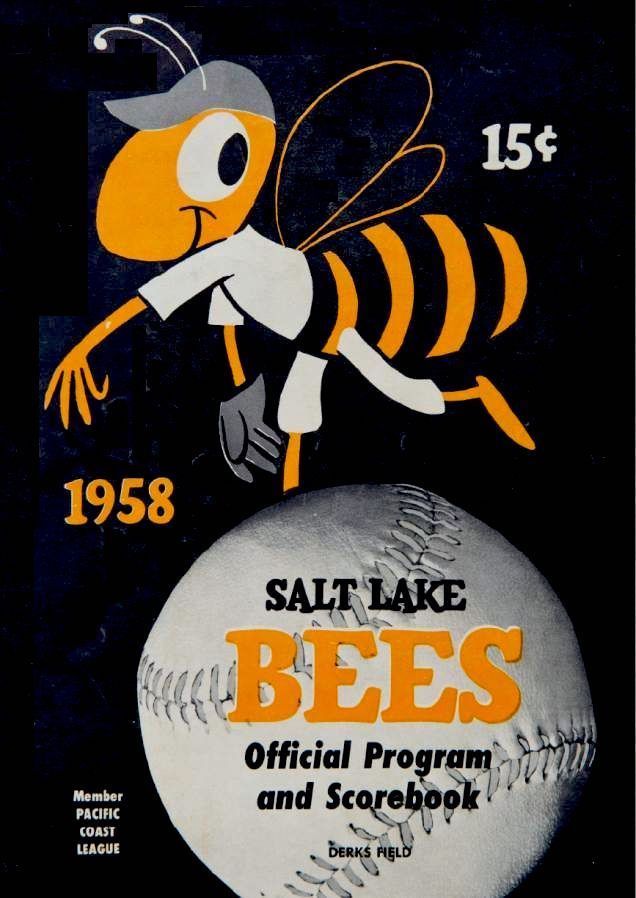
"All the glitz and glamour of the Stars! All the excitement! All the... oh, dear... NO REFUNDS!" |
¹⁴—"Salt Lake City Obtains Stars", by Hank Hollingsworth, The Independent, Long Beach, California; 06 December 1957, Friday; Page 33. "Hollywood franchise owner Bob Cobb, backed into a corner because he had no other place to go, apparently completed sale of his club to Salt Lake City Thursday and took a financial setback in so doing. Salt Lake City, sportsman Nicholas (Swiftie) Morgan virtually withdrew his offer to buy Cobb's franchise 24 hours ago, but a retreat by Cobb opened up new negotiations and enabled the Salt Lake City group to secure the ex-Stars on their terms. Consequently, the new Pacific Coast League alignment appeared set as announced tentatively three days ago with the league composed of five old franchises and three new ones (Salt Lake City, Spokane and Phoenix). Cobb was reluctant to agree to Morgan's terms Thursday and made a final pitch to the league to consider Long Beach at a site for his organization. Cobb asked for more time to confer with 'certain people' in Long Beach, but the league directors insisted that he make a satisfactory arrangement with Salt Lake as soon as possible."
¹³—"Birmingham's Gail Patrick Tries Not To Be Female," by Gene Handsaker, The Montgomery Advertiser, Montgomery, Alabama, 05 Jan 1958, Sunday; Page 40. "For eight of the 10 years since she quit the screen she ran a swank dress shop for children in Beverly Hills. She does the family cooking. Hand-wove material for stoles for herself and a friend and for a cashmere sport coat for her husband. Campaigned for President Eisenhower in the last election. Used to fly airplanes. Is still a heavy stockholder in the Hollywood Stars baseball club, to whose President, Robert Cobb, she formerly was married."
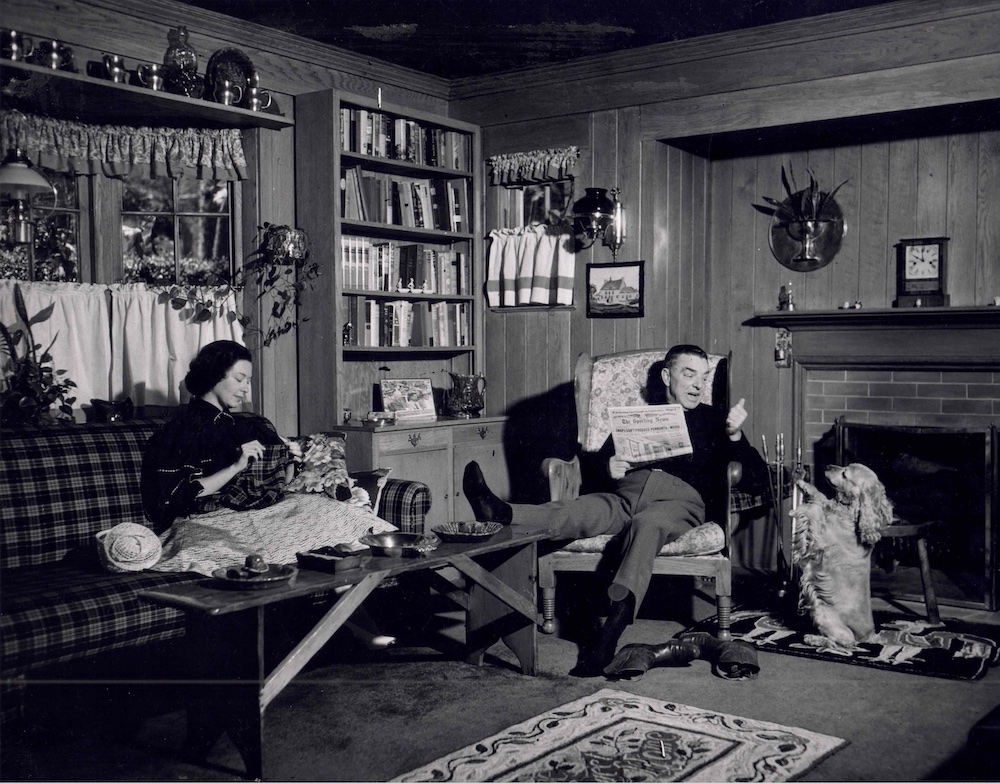
Bob Cobb kicks off his boots and relaxes at 1320 Stone Canyon Road, with his second wife, Sally—away from the Stars and the stars. The Bel Air house out-lived all of the Brown Derbies, which fell out of favor as the film studios moved out of Hollywood. |
¹⁵—"Bob Cobb Fights On," from "The Inside Track" by Sid Ziff, Mirror News, Los Angeles, California; 05 Sep 1957, Thursday; Page 33: "Well-meaning newspapermen are promoting Cobb for a high position in the Brooklyn organization. 'I'm not seeking any position anywhere,' he said firmly. 'I've had a business for 40 years (the Brown Derby chain of restaurants) and I love and am proud of it. I don't want to be a big shot in baseball; I just want to give L.A. the best recreation center in the world.' Cobb has been stumping for an all-purpose sports center In Chavez Ravine. The Hollywood Stars have been operating for 20 years. Did it make or lose money? Says Cobb: 'The stockholders haven't got their original investment back yet.' Asked for a more specific breakdown, he said if an original stockholder had put in $100 20 years go he would have gotten back only $80. None of the officers of the club drew a dime in salary for 16 years, Cobb said proudly. This included the president, vice-president, secretary and treasurer, the executive board and the board of directors. What happened In the letter years? 'I borrowed from Pittsburgh to pay off Victor Ford Collins and George Young when they wanted to sell their stock,' said Cobb. 'My purpose was to get a respectable club for Hollywood by tying up with Pittsburgh. It worked out very welL We won three pennants end tied for one, were second twice and third once in the years we've been associated with Branch Rickey.' (The Pittsburgh deal came after Rickey left Brooklyn.)"
¹⁶—"Bing Crosby Buys 10 Shares Of Stock in Billings Team", Great Falls Tribune, Great Falls, Montana; 21 December 1947, Sunday; Page 11. "Crosby is also half owner of the Pittsburgh Pirates and has an interest in the Hollywood Stars."
¹⁷—"Billings Pioneer League Club Incorporates, Names Directors", UP, Great Falls Tribune, Great Falls, Montana; 05 November 1947, Wednesday; Page 9. "Eleven directors were named in the articles, including Robert H. Cobb of the Hollywood Stars baseball team in the Pacific Coast league and Gordon S. (Mickey) Cochrane of Detroit. Mickey Cochrane is the former Philadelphia Athletics and Detroit Tiger star. ... In Hollywood, Cobb, vice president of the Hollywood Stars, said he hoped to make the team a Hollywood farm, sending 19 players from his Pacific Coast league squad to Billings for training each season... A Billings boy, he worked in a bank there before going to California 30 years ago. He said the details had not yet been worked out but he expected several stockholders of the Hollywood club, among them Helena-born Gary Cooper, William Frawley, Gail Patrick, Robert Taylor, Barbara Stanwyck and De Mille to take stock in the new club, which with Great Falls will boost the Pioneer league to an eight-club circuit."
|
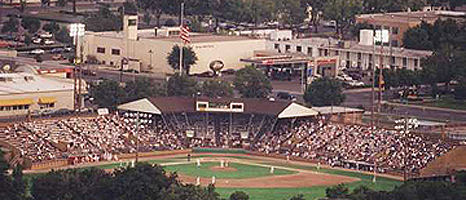
| Cobb Field in Billings, Montana (1948-2007), home of the Mustangs. |
Written by Jeff Hause. Thanks to Vice President Mark Panatier of the A.F. Gilmore Company, for his assistance in the researching of this article. Below is some old footage of the Stars attached to the song "Centerfield" by John Fogerty. Trivia Fact: Fogerty grew up in El Cerrito, in Southern California, and the lyrics, "rounding third, headed for home" were actually Fred Haney's sign-off after Stars radio and TV broadcasts for that area.
|